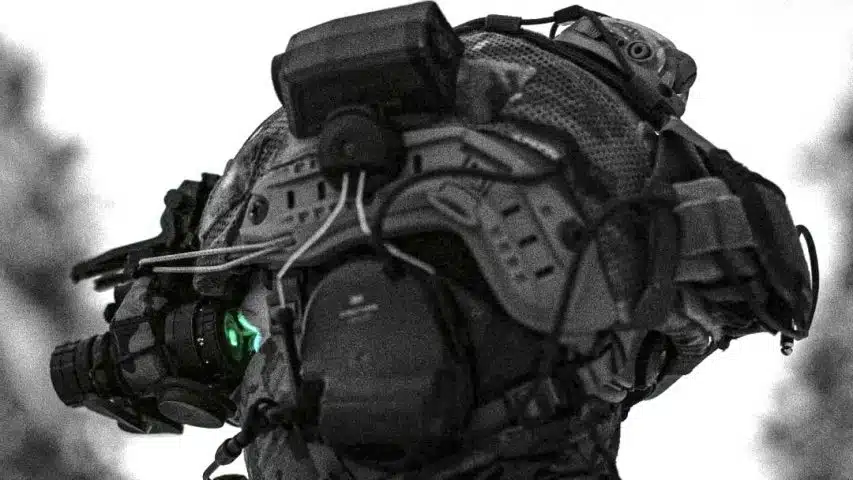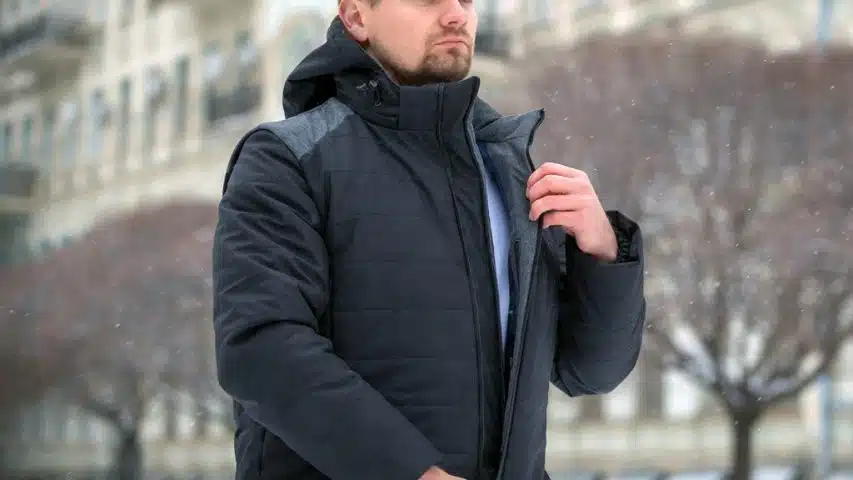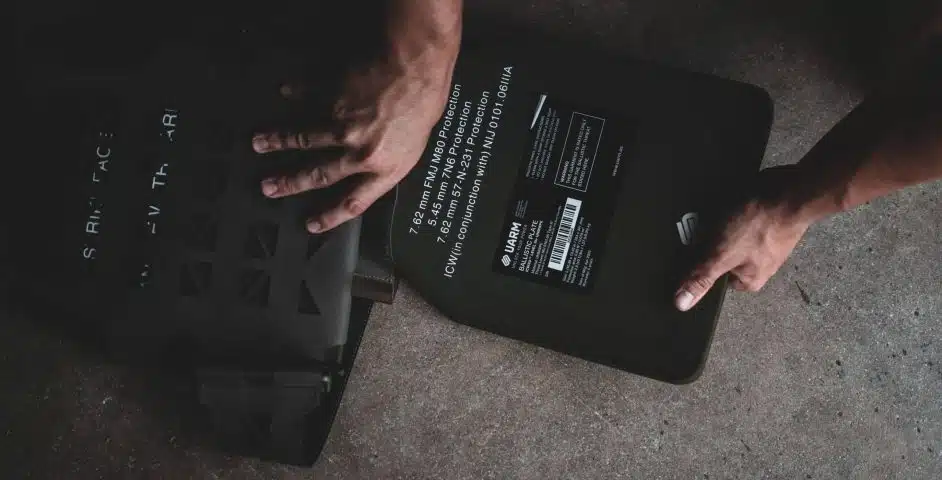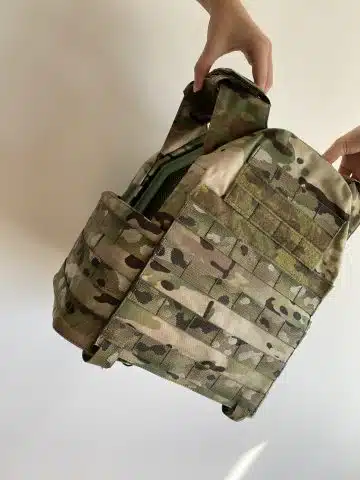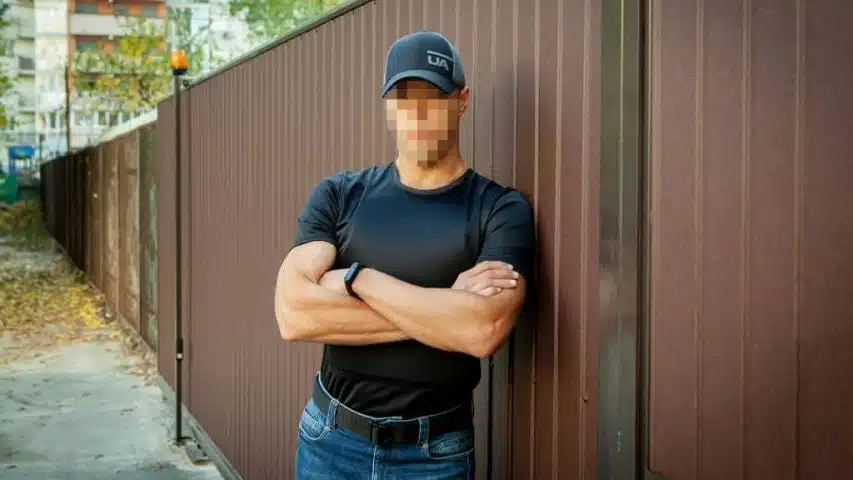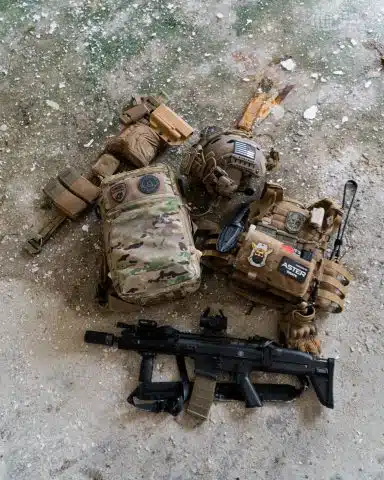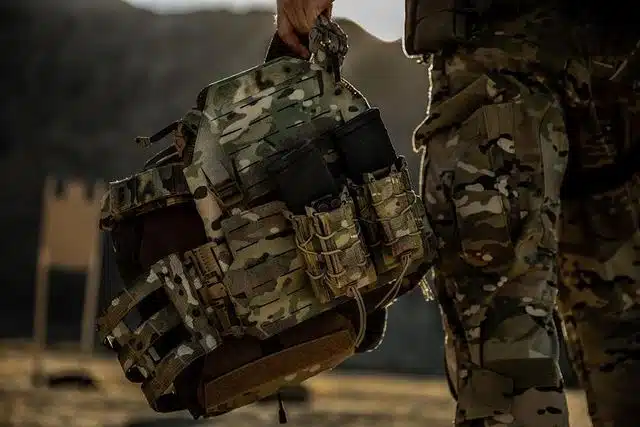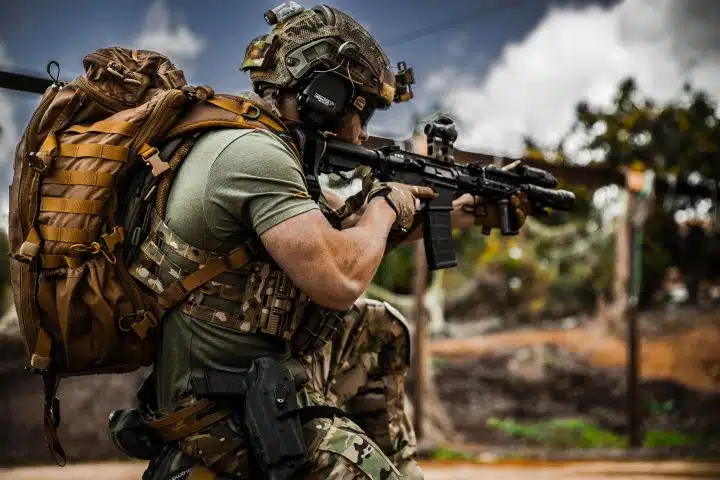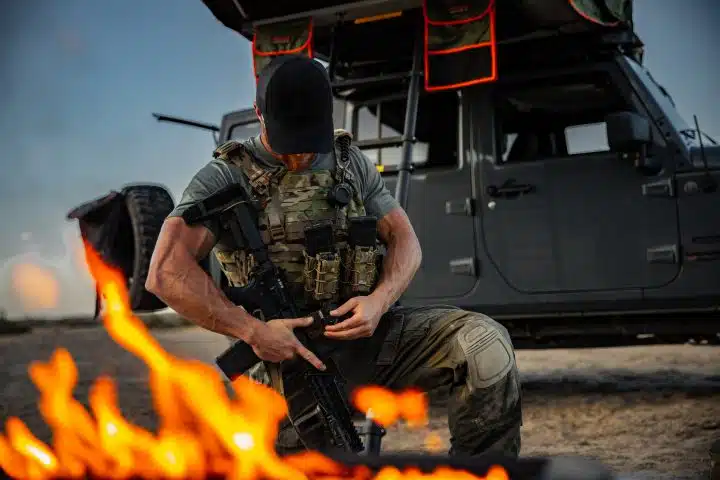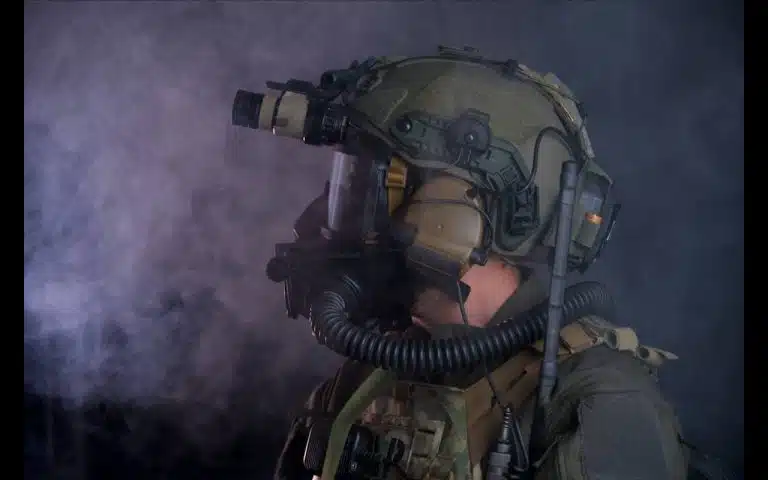Every material is bulletproof if you lay it on thick enough, and no material is bulletproof if you have a big enough bullet. What materials are used to make vests bulletproof in particular are bound by what you can carry and what modern weaponry you can expect in the field.
For this purpose, we can look at three categories of materials:
- High-density materials
- High-tensile fibers
- Composite ceramics
But, not every dense material will be ideal for body armor. Some metals are rather tough when thick, but are generally easy to pierce or fracture. Even novel materials like graphene that can pull tons in one direction would fracture from a bullet.
Thankfully, some compounds are both flexible and tough in their molecular structure, allowing for perfect anti-ballistic capabilities.
In some cases, these materials aren’t suitable for vests, usually because of their rigidity or weakness to lateral impact. But in others, they can even make soft and flexible pads that will easily prevent a bullet from passing through.
There Is no Such Thing as Bulletproof
Again, all of these materials are ‘bullet-resistant’ due to their anti-ballistic characteristics. But, nothing is completely bulletproof.
The biggest caliber that can still be considered a bullet is a .950 JDJ, which weighs half a pound per round. While this is not something you will ever see shot from human hands in a reasonable situation, as that rifle alone weighs around 60lbs, it will pass through even the thickest NIJ Level IV plate.
These extremes are important to keep in mind when selecting plates because you are not aiming for perfect protection. Rather, you should look for the optimal characteristics of some material.
Silicon Carbide may be tougher than UHMWPE but is also much heavier. And, you don’t need to lug around dozens of pounds of armor if you are in a domestic situation and will only encounter handguns, for which the ammo can be stopped with lightweight soft armor.
Physics of Projectile Impact
To gain a better idea of why some materials work as bulletproof vests and others don’t, we first need to know what happens when something gets hit with a bullet.

While for us it seems that the bullet is just punching a hole in something, the truth is much more fascinating. Generally, any projectile works in the same way as a knife. It applies force to a point and causes molecules to separate, letting the bullet pass through.
And, because the power this little piece of metal is carrying is so big and its size so small, it is easy for it to pass through multiple layers of most materials, often leaving just the small puncture.
Here we realize that the only way to make anti-ballistic material is to find something that will either suck in all of the force of the bullet quickly or something that won’t rip from such force, but rather bend and absorb.
Transference of Force
Not to engage with the concepts of energy, work, and force, everyone buying ballistic armor should have at least a basic grasp of the transference of force. Each material will absorb and transfer some portion of the force applied to it, depending on several factors.
The best way to imagine this is with a boxing glove. When you are punching with a glove on, you are not actually hitting your opponent, but the glove. Then the force is transferred from the kinetic energy of your fits to the target via the foam inside the glove.
As everyone knows, this makes the punch hurt less, but also lowers the reciprocal force to your fist, reducing the chance that you will break your hand.
A similar action happens with body armor, both when it comes to soft ballistic panels and hard plates. The point of the armor is not only to stop the projectile but to reduce how much force is being transferred to the body of the operator.

This can be done by dispersing the force to both a wider field and transferring it outwards and sideward as much as possible. Some force will always find its way to the operator, but with good body armor, this can be reduced from a sledgehammer to the chest to a mediocre slap.
Newton’s per Second
Every material can absorb a certain amount of joules without being broken, penetrated, or moved in its entirety. Joules represent how much Newtons are applied to each kilogram in one second.
For fired bullets, especially from longer barrels like rifles, this power can be substantial. That is why only hard armor can stop rifle bullets, even if you are shooting the same caliber. Because the acceleration on the projectile is greater, so is the speed, making it more powerful.
To a point, the soft fibers in ballistic panels will ‘catch’ the bullet and bend so to use tensile strength to draw the force to the sides. The bullet may break the first few layers of the fibers but isn’t fast enough to break enough to remove the anti-ballistic effect.
But, if the bullet is too fast, particularly large, or usually both, there won’t be enough fibers to slow the bullet enough for this effect to take place.
Soft ballistic plates aren’t ineffective against rifles because they are not strong enough. That is why the same materials as UHMWPE are often used in both soft and hard armor. Rather, they aren’t dense enough to start the process before the bullet passes through them.
This can be solved either by increasing the density and thickness of the armor and thereby letting some material decrease the speed before the rest starts working, or to reinforce the original material with something tougher in-between the fibers.
Pounds per Square Inch
The reason why bullets are such great weapons is not just the power of the shot. In terms of kinetic value, a crossbow bolt can deliver as much power as a pistol round. But, that power will be spread over a wider surface on impact, and inside a much larger projectile.
That is why materials that can easily stop an arrow will let a bullet pass easily. Fraction of an inch needed for the bullet to pass friction is considerably less, especially at higher speeds.
For this purpose, all types of ballistic materials need to be able to both slow down and stop the projectile as much as possible, as well as to increase friction. Some natural materials line aluminum oxide have this capability on their own, as the metal expands and contracts on the bullet itself.
Other materials like UHMWPE need tensile strength to flex and move in multiple directions. This forces the projectile to go around every individual string, increasing the area tremendously and thus reducing the force transfer per square inch.
Toughness and Flexibility
All ballistic materials need to be both tough and flexible. With the last point, we have seen that it is much better to have something that will bend and absorb the bullet than something where the bullet will either bounce off or break the material.

Additionally, when it comes to wearable ballistic materials there is the question of weight. While many things are stronger than a bullet, rarely that is the case for something you can carry around easily.
For example, a homogenous block of quartz is, for the lack of a better word, bulletproof. No bullet will ever rip through quartz. But, it will make the crystals shatter unless they are adequately thick. This means that a ballistic plate made from quartz would need to be ~80lbs in weight.
On the other size, a ballistic plate made from Silicon Carbide is less than 8lbs, or 10x less than quartz. This makes such plates possible for wearing around and staying mobile.
Non-Wearable Ballistic Materials
Before we mention current materials used for bulletproof vests, it is good to know that other materials are resistant to projectiles that are not wearable.
Usually, the main reason for some material being impractical in a ballistic vest is the weight. Most materials only become resistant to common firearms at a thickness that would be impossible to carry around.
Also, there is rigidity. Some materials are extremely durable in one direction while being very brittle from the sides. For a long time, this was an issue with hard armor plates as they needed to be encased in something that would absorb lateral hits.
These materials are often used in construction and security features like armored windows. Generally, a thick enough wall of armored concrete can stop anything, including nuclear weapons. But, that is not something you would ever move once it sets… even if you want to.
Wood
Wood works on the same principle as soft ballistic armor. This is the reason why it was used as material for shields for such a long time. Thin strips of wood glued tightly together make the same tensile effect as fibers in aramid.
But, the issue with wood is that it is also full of water and other materials except for the fibers, and even those fibers are not ideally homogenous.
This is why a wooden shield can easily stop an arrow, but most bullets will pass right between the fibers and into the user behind. The fibers start catching handgun bullets when they are about two inches thick, which is too much for anyone to carry.
Fiberglass and Polycarbonate
Fiberglass and polycarbonates are very strong on their faces and relatively brittle on the sides. Additionally, they are not flexible at all and are made to shatter when under too much stress.
This makes fiberglass ideal for cars and buildings, as it gives additional safety that it won’t break into sharp glass but rather hexagonal chunks. Properly treated, they can stop all kinds of bullets.
Armored glass doesn’t need to be that thick to be resistant to handgun ammo. But, regardless of its frontal durability, its brittleness makes it completely impractical to wear on your person.
Traditional Ballistic Materials
Armor is much older than firearms. While the first portable ”fire lances” were made in the 13th century, the first armors were older than antiquity. For this reason, people first tried to adapt current materials so that they would stop gunfire projectiles.
As previously mentioned, wood was quickly disregarded. But, in many places in the world people noticed that thick pressed cloth had much better results.
Also, those wearing steel armors were safer for a long time, as high-quality steel needs to be just a bit thicker than medieval armor to be impervious to handguns.
But, once modern cased bullets started being fired from rifled guns, these materials became obsolete.
Compressed Fiber
While the first actual ballistic body armor was made in Korea, the idea of how compressed fiber will stop gunshots was known in most parts of the developed world. For such reason, European soldiers had a bible on their hearts because the thin pages would work as armor.
In Korea, they found out that compressing multiple layers of thin linen cloth stops all types of bullets. This principle was then adapted by the French, then the Americans, then the rest of the world.
A similar principle works even today, albeit with more modern materials.
Steel
This was an obvious choice and the main type of armor in Europe, India, and the Americas for quite a while. But, as the guns became better the steel needed to be thicker. At some point, most soldiers only wore a breastplate, for the same reasons we only wear a ballistic plate on our chest now: weight.

Only once people learned that the same result can be made with linen they tossed aside full steel plate and only used a thin sheet over the fiber.
Novel Ballistic Materials in Vests
Finally, new materials are made to withstand modern weaponry, which is by far stronger than anything we had even 100 years ago, let alone before that.
Generally, there are only three base materials that new armor is made from Aramid, Aluminum, and Polyethylene. All of these are used at different strengths, and for different reasons.
Additionally, there are modulations and amalgamations of these materials with others, where ingredients are added to further reinforce the armor. There are even ceramic materials added to make parts tougher, especially on the strongest armors.
Aramid
Aramid is a truly wonderful material. It is simultaneously ‘space-age’ and works on the oldest ballistic principle imaginable.

It works like chain-mail, but on a molecular level. Strings of aramid are pressed together to make sheets like in the linen cloth originally. But, unlike linen, aramid has a much stronger connection to itself and can pull the entire string every time one part is pressed.
This quality makes it ideal as soft armor, as it is flexible on slow touches and only becomes firm once it encounters something really fast.
Further, there are deviations on aramid, such as Kevlar® or Nomex® that alter the molecular structure a bit to make it even stronger. In the case of Kevlar®, it also makes it a bit more rigid, making it slightly less practical for army use, but very popular for civilians as it is stab-proof.
Aluminum Oxide
Aluminum Oxide is a very obvious choice when it comes to ballistic materials, and is still one of the most common types of armor, mainly because of its price and availability.

Its ballistic properties have everything to do with the molecular structure inside. When looked at as a whole, it seems like rows of interchangeable zig-zags that press onto each other. This makes the material both very firm, but also quite flexible.
When under fire, the pattern bends and forces the rest to squeeze the bullet, slowing it down and stopping it in its tracks.
This does make Al2O3 armor slightly heavier than the rest, but not as much that it is unbearable.
Polyethylene
This is one of the best materials to come out in the last 100 years. Polyethylene is a plastic that is quite easy to manufacture and it is mostly air. But, when it is made in its ‘’ultra-high-molecular-weight’’ form, or as UHMWPE, it becomes very resistant to bullets.

The extremely long chains of polyethylene create the same effect as all fibers. But, the strong hydrogen bonds make its tensile strength unmatched by anything else. This is why a very light hard plate made from UHMWPE can stop even rifle rounds.
Ceramic
Finally, there are ceramic compounds that might be brittle once impacted but will stop several shots from some of the strongest infantry rifles out there. Usually, they are made by applying meshes of very tough material to rows of fibers, to get the best of both worlds.

But, the ceramic itself is quite astounding. It works similarly to aluminum oxide, only better.
In most cases, it will both bounce off the force of the bullet but not the projectile itself. This projectile will be caught by the material and stopped.
The downside is that such materials are still somewhat expensive to make and armor made from silicon carbide, while one of the strongest you might find, is also one of the most expensive.
Theory and Tendencies
The future for body armor is unpredictable as we never know which types of weapons will be found. There is always an arms race between bullets and bullet-stopping materials.
But, in the short term, some things are probable. For one, current components will become better and cheaper for the users. Manufacturers are always refining their processes and trying to find ways to make their armor even stronger and even lighter.
Additionally, there might be some mixtures like using aramid pulp in an epoxy resin to make armor against explosives as thin and light as regular clothes. This is still in the works, but we ought to see it in the next decade.
And finally, tactics are always changing. The best armor will forever be not being shot in the first place, and we are constantly trying to find ways to remove the risk for humans from combat as much as possible.

